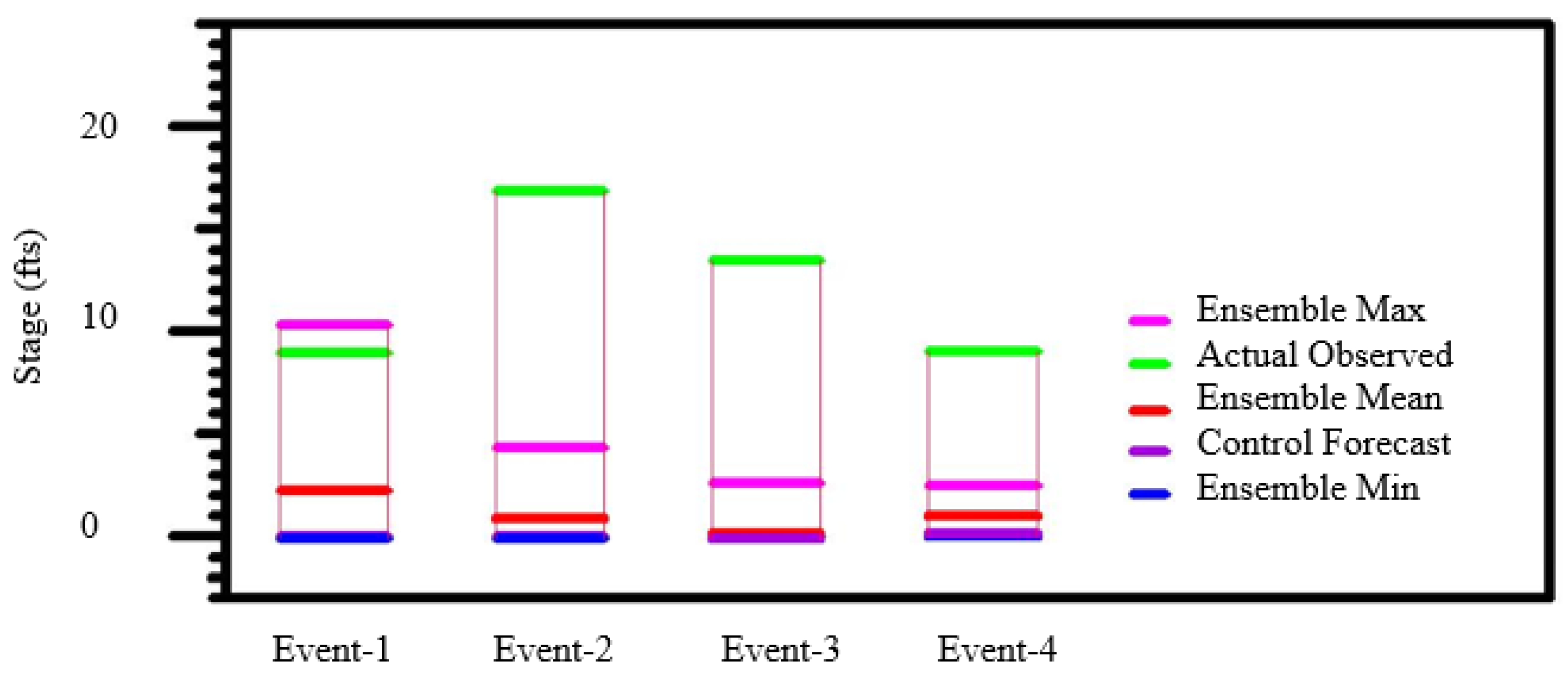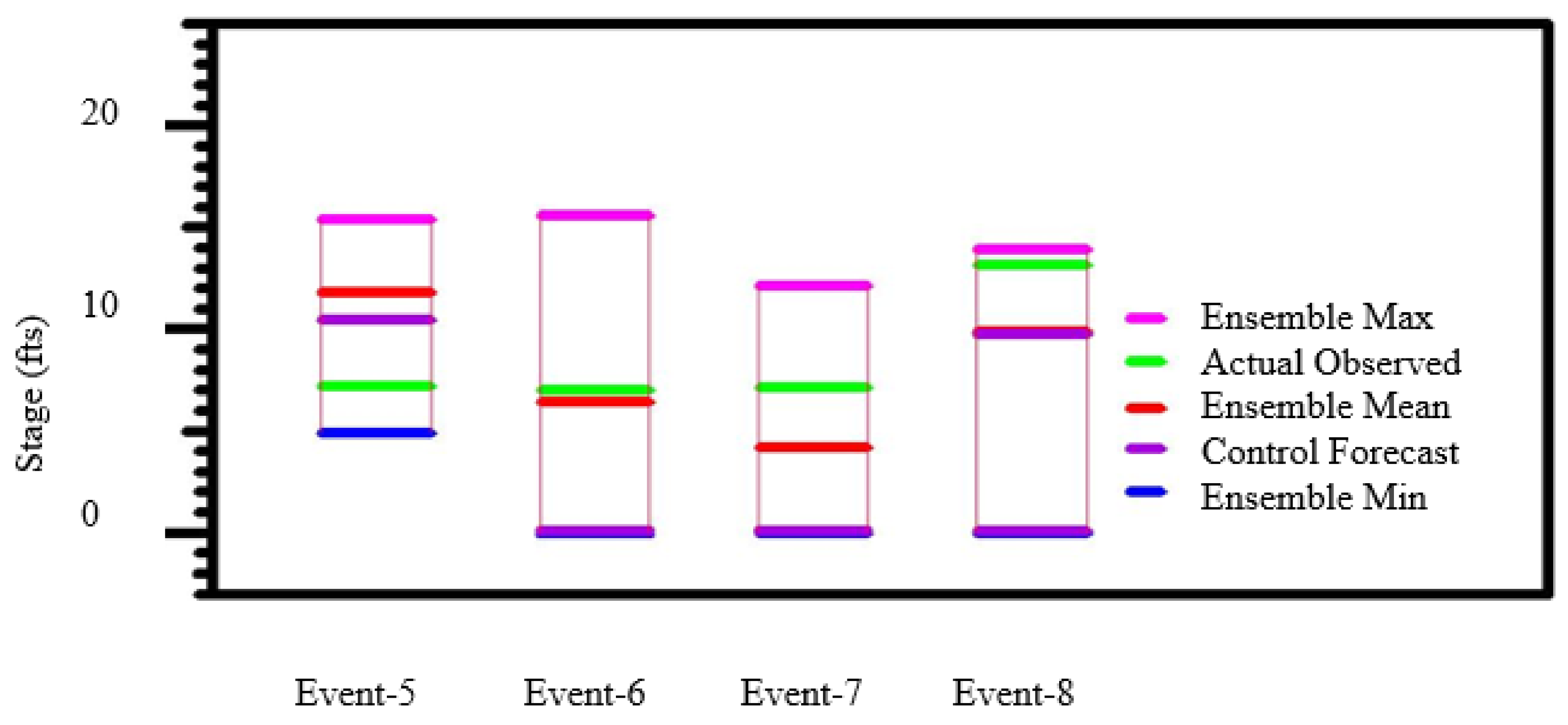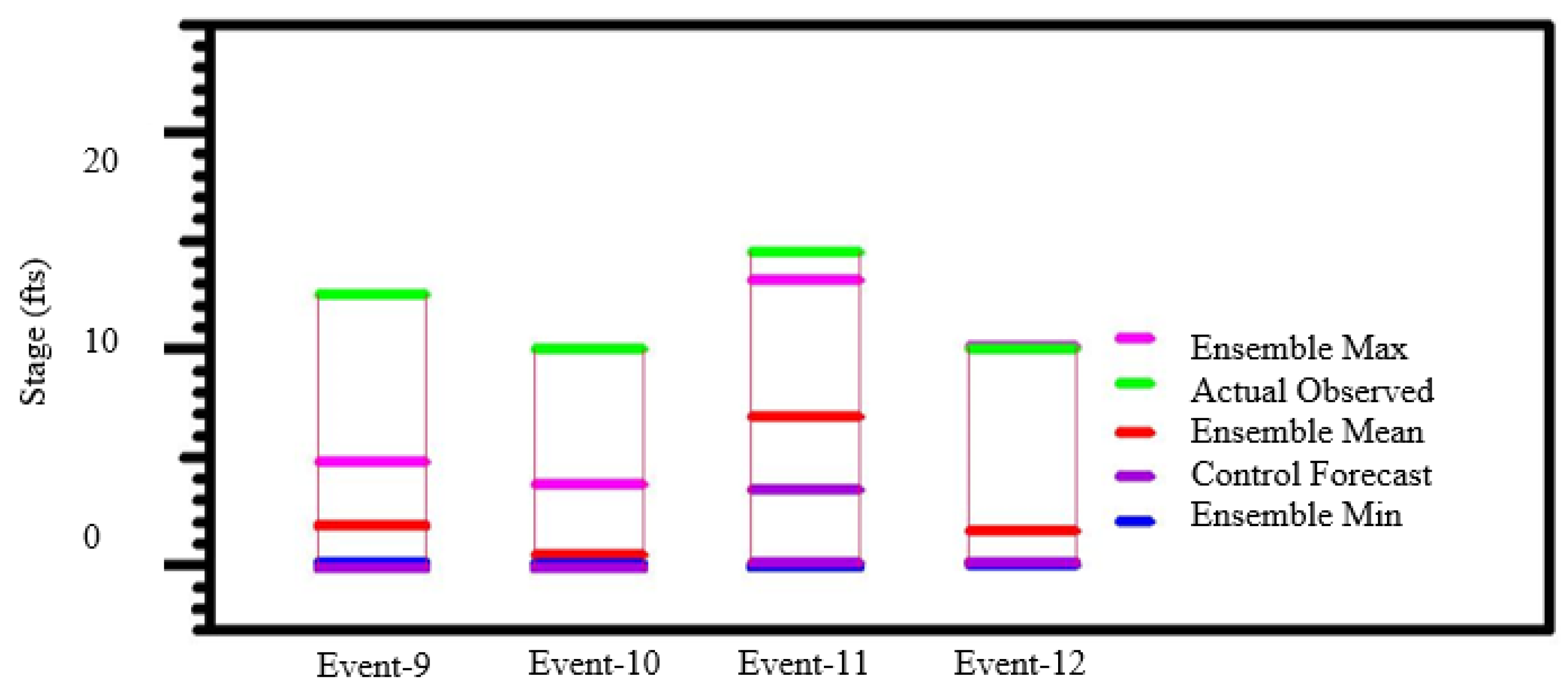Advance Ensemble Flood Warning System: A Case Study for Nullah Lai †
Abstract
:1. Introduction
2. Procedural Background
2.1. Forecast Data
2.2. Rainfall and Stage Data
2.3. Digital Modelling of Nullah Lai Catchment
2.4. Observed Rainfall—Stage Modelling
- Stage is denoted as “S”
- Basin mean of rainfall is denoted as “P”.
3. Materials and Methods
4. Results and Analysis
Ensemble Predicted Stage vs. Actual Stage
5. Conclusions
- 1.
- The Nullah Lai watershed was digitally modelled using the latest version of ArcGIS 10.3.1. This model was made using the most accurate digital elevation data from the USGS;
- 2.
- The model was able to produce a root mean square of 77% and a correlation coefficient of 0.88. The data collected during the period indicated that the model is very accurate;
- 3.
- The forecasting system was used to study 12 extreme events that occurred from 2017 to 2019. Out of these, seven events were within the range of the ensemble forecast. The results show that the ensemble forecast is more accurate than the control forecast when it comes to forecasting events.
Author Contributions
Funding
Institutional Review Board Statement
Informed Consent Statement
Data Availability Statement
Acknowledgments
Conflicts of Interest
References
- Khummongkol, R.; Sutivong, D.; Kuntanakulwong, S. Water Resource Management Using Multi-Objective Optimization and Rainfall Forecast. In Proceedings of the 2007 International Conference on Convergence Information Technology (ICCIT 2007), Gwangju, Republic of Korea, 21–23 November 2007. [Google Scholar]
- Borga, M.; Anagnostou, E.; Blöschl, G.; Creutin, J.-D. Flash flood forecasting, warning and risk management: The HYDRATE project. Environ. Sci. Policy 2011, 14, 834–844. [Google Scholar] [CrossRef]
- Siccardi, F.; Boni, G.; Ferraris, L.; Rudari, R. A hydrometeorological approach for probabilistic flood forecast. J. Geophys. Res Atmos. 2005, 110. [Google Scholar] [CrossRef]
- Cloke, H.; Pappenberger, F. Ensemble flood forecasting: A review. J. Hydrol. 2009, 375, 613–626. [Google Scholar] [CrossRef]
- Taylor, J.; Buizza, R. Neural network load forecasting with weather ensemble predictions. IEEE Trans. Power Syst. 2002, 17, 626–632. [Google Scholar] [CrossRef]
- Shoaib, M.; Shamseldin, A.Y.; Khan, S.; Khan, M.M.; Khan, Z.M.; Sultan, T.; Melville, B.W. A comparative study of various hybrid wavelet feedforward neural network models for runoff forecasting. Water Resour. Manag. 2018, 32, 83–103. [Google Scholar] [CrossRef]
- Shaukat, R.S.; Khan, M.M.; Shahid, M.; Shoaib, M.; Khan, T.A.; Aslam, M.A. Quantitative Contribution of Climate Change and Land Use Change to Runoff in Tarbela Catchment, Pakistan. Pol. J. Environ. Stud. 2020, 29, 3295–3304. [Google Scholar] [CrossRef] [PubMed]
- Hammad, M.; Shoaib, M.; Salahudin, H.; Baig, M.A.I.; Khan, M.M.; Ullah, M.K. Rainfall forecasting in upper Indus basin using various artificial intelligence techniques. Stoch. Environ. Res. Risk Assess. 2021, 35, 2213–2235. [Google Scholar] [CrossRef]
- Shoaib, M.; Shamseldin, A.Y.; Melville, B.W.; Khan, M.M. Runoff forecasting using hybrid wavelet gene expression programming (WGEP) approach. J. Hydrol. 2015, 527, 326–344. [Google Scholar] [CrossRef]
- Krzysztofowicz, R. The case for probabilistic forecasting in hydrology. J. Hydrol. 2001, 249, 2–9. [Google Scholar] [CrossRef]
- Khan, M.M.; Shamseldin, A.Y.; Melville, B.W. Impact of ensemble size on forecasting occurrence of rainfall using TIGGE precipitation forecasts. J. Hydrol. Eng. 2014, 19, 732–738. [Google Scholar] [CrossRef]
- Khan, M.M.; Shamseldin, A.Y.; Melville, B.W.; Shoaib, M. Impact of ensemble size on TIGGE precipitation forecasts: An end-user perspective. J. Hydrol. Eng. 2015, 20, 04014046. [Google Scholar] [CrossRef]
- Ahmad, B.; Kaleem, M.S.; Butt, M.J.; Dahri, Z.H. Hydrological modelling and flood hazard mapping of Nullah Lai. Proc. Pak. Acad. Sci. 2010, 47, 215–226. [Google Scholar]
- Morss, R.E.; Emanuel, K.A.; Snyder, C. Idealized adaptive observation strategies for improving numerical weather prediction. J. Atmos. Sci. 2001, 58, 210–232. [Google Scholar] [CrossRef]





Disclaimer/Publisher’s Note: The statements, opinions and data contained in all publications are solely those of the individual author(s) and contributor(s) and not of MDPI and/or the editor(s). MDPI and/or the editor(s) disclaim responsibility for any injury to people or property resulting from any ideas, methods, instructions or products referred to in the content. |
© 2023 by the authors. Licensee MDPI, Basel, Switzerland. This article is an open access article distributed under the terms and conditions of the Creative Commons Attribution (CC BY) license (https://creativecommons.org/licenses/by/4.0/).
Share and Cite
Siddiqui, M.A.; Khan, M.M.; Khan, R.; Shah, S.A.R. Advance Ensemble Flood Warning System: A Case Study for Nullah Lai. Environ. Sci. Proc. 2023, 25, 96. https://doi.org/10.3390/ECWS-7-14197
Siddiqui MA, Khan MM, Khan R, Shah SAR. Advance Ensemble Flood Warning System: A Case Study for Nullah Lai. Environmental Sciences Proceedings. 2023; 25(1):96. https://doi.org/10.3390/ECWS-7-14197
Chicago/Turabian StyleSiddiqui, Muhammad Aamir, Mudasser Muneer Khan, Rabia Khan, and Syyed Adnan Raheel Shah. 2023. "Advance Ensemble Flood Warning System: A Case Study for Nullah Lai" Environmental Sciences Proceedings 25, no. 1: 96. https://doi.org/10.3390/ECWS-7-14197
APA StyleSiddiqui, M. A., Khan, M. M., Khan, R., & Shah, S. A. R. (2023). Advance Ensemble Flood Warning System: A Case Study for Nullah Lai. Environmental Sciences Proceedings, 25(1), 96. https://doi.org/10.3390/ECWS-7-14197




